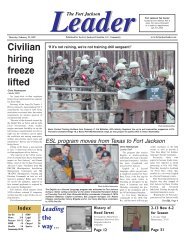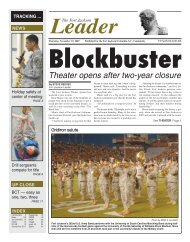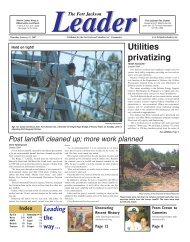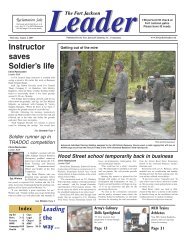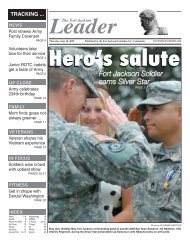BCT Soldiers clinch MAC 1 - Fort Jackson - U.S. Army
BCT Soldiers clinch MAC 1 - Fort Jackson - U.S. Army
BCT Soldiers clinch MAC 1 - Fort Jackson - U.S. Army
You also want an ePaper? Increase the reach of your titles
YUMPU automatically turns print PDFs into web optimized ePapers that Google loves.
Health<br />
Resolve to make reinforced resolutions<br />
Kelly Forys<br />
U.S. <strong>Army</strong> Center for Health Promotion<br />
and Preventive Medicine<br />
Lose weight, develop a better diet, exercise<br />
more, spend more time with family,<br />
pay off debt, quit smoking.<br />
How many people have made one or<br />
more resolutions like this, or have heard<br />
friends and family members set similar<br />
goals on New Year’s? Then, how many<br />
people have experienced the let-down that<br />
occurs after not being able to stick to the<br />
goal in February or March? It can be<br />
tough.<br />
For those who have found it difficult to<br />
stick to a resolution in the past, the problem<br />
might not be a lack of will-power.<br />
Rather, the goals might not have been realistic<br />
or measurable.<br />
One of the most popular New Year’s<br />
resolutions is to lose weight. Losing<br />
weight can certainly improve health, and a<br />
resolution to do so can be a great motivator.<br />
However, following some simple<br />
guidelines when creating a resolution can<br />
Cold-weather injuries pose risk to <strong>Soldiers</strong>’ readiness<br />
Paul Repaci and Lt. Col. Diego Gonzales<br />
U.S. <strong>Army</strong> Center for Health Promotion<br />
and Preventive Medicine<br />
Cold-weather injuries remain a significant problem<br />
during training and combat operations, affecting <strong>Soldiers</strong>’<br />
health and readiness. Cold-weather injuries include<br />
injuries caused by decreased temperatures, heaters, carbon<br />
monoxide poisoning, sunburn and snow blindness,<br />
and accidents caused by impaired physical and mental<br />
function resulting from cold stress.<br />
The Armed Forces Health Surveillance Center reported<br />
238 cases of cold injury among active-duty service<br />
members during the 2007-2008 cold-weather season.<br />
Frostbite was the most frequently reported cold injury<br />
(50 percent), followed by unspecified (29 percent), immersion<br />
foot (11 percent) and hypothermia (10 percent).<br />
The highest rates of cold injuries occur among the<br />
youngest enlisted <strong>Soldiers</strong>.<br />
Commanders, supervisors and <strong>Soldiers</strong> at all levels<br />
must implement countermeasures to prevent cold injuries.<br />
These include proper clothing and equipment; training<br />
on cold-weather clothing and equipment; adequate<br />
food, water, shelter and rest; and other preventive measures.<br />
Cold weather-related injuries<br />
— Frostbite: Frostbite is the most common type of<br />
freezing injury, caused by prolonged exposure to freezing<br />
temperatures. Severe frostbite can have devastating consequences,<br />
including the loss of fingers, toes or limbs.<br />
— Immersion/trench foot: Immersion foot or trench<br />
foot is observed in people whose feet have been wet, but<br />
not freezing, for prolonged periods. It may occur at temperatures<br />
near or slightly above freezing and is usually<br />
greatly improve the chances of success.<br />
Set a realistic goal<br />
If you have many things in your life<br />
that you would like to change, start by<br />
choosing one. Changing life behaviors is<br />
very difficult, and if you choose one behavior<br />
at a time, you will focus better and<br />
make progress toward achieving that goal.<br />
Also, the goal should be realistic.<br />
If you want to<br />
lose 50 pounds, don’t<br />
expect to lose 10<br />
pounds in the first week.<br />
Products on infomercials<br />
that promise huge<br />
weight loss are likely ineffective<br />
or can even be<br />
harmful.<br />
Set a specific goal<br />
A vague goal of losing weight is not<br />
helpful. In addition to being realistic, the<br />
goal should be specific. A goal of losing 5<br />
pounds in the next two months is realistic<br />
and specific. Another approach is to set<br />
specific and measurable behavioral goals<br />
such as exercising three times per week or<br />
eating three servings of vegetables every<br />
day.<br />
Identify potential barriers<br />
Think of barriers to your goal and ways<br />
that you will overcome them. For example,<br />
your goal might be to eat healthy<br />
foods while you are pulling night duty;<br />
however, a barrier<br />
might be that at that<br />
time of night, fastfood<br />
restaurants<br />
are the only places<br />
to get food.<br />
Ask your fellow<br />
<strong>Soldiers</strong> to<br />
help you think of<br />
obstacles to your<br />
goal and solutions to<br />
work around those obstacles.<br />
Your fellow <strong>Soldiers</strong> might suggest that<br />
you stop at the deli and purchase a healthy<br />
sandwich before you report for night duty,<br />
so that you can eat that instead of going to<br />
a fast-food restaurant.<br />
associated with inactivity and wet or damp socks and<br />
boots.<br />
— Chilblain: Chilblain occurs after exposure to nonfreezing<br />
temperatures and damp conditions. Chilblain<br />
causes skin lesions (blisters, erosions or ulcers) in unprotected<br />
extremities such as hands, feet and face. It occurs<br />
12 to 24 hours after exposure. The lesions usually resolve<br />
spontaneously in one to three weeks, but they may recur<br />
in some people.<br />
— Hypothermia: Hypothermia is the lowering of the<br />
body’s core temperature. It is an emergency requiring immediate<br />
care.<br />
Accidental hypothermia kills more than 650 people<br />
per year in the United States, usually resulting from<br />
unanticipated exposure to cold weather in an inadequately<br />
prepared person caught off guard by the elements.<br />
It is classified as mild, moderate or severe based<br />
on core body temperature. Symptoms range from shivering,<br />
irritability and confusion to unconsciousness and<br />
death.<br />
— Sunburn and snow blindness: Sunburn can occur in<br />
cold environments, leading to painful, red, swollen, blistered<br />
skin. It can be prevented by proper use of sunscreen.<br />
Snow blindness, like sunburn, is caused by the intense<br />
UV rays of the sun in snow-covered surroundings. Symptoms<br />
include painful, red, watery or gritty eyes caused by<br />
burning of the cornea. Snow blindness can be prevented<br />
by wearing sunglasses with side protection.<br />
What <strong>Soldiers</strong> should do<br />
— Become familiar with the causes and risks of cold<br />
injury and the personal protective measures to prevent<br />
them.<br />
It may seem discouraging to think<br />
about the barriers that might block you<br />
from reaching your goals; however, if you<br />
are able to identify the barriers that might<br />
get in your way, you can plan how to<br />
eliminate them.<br />
Engage support from others<br />
Don’t underestimate the power of social<br />
support. Tell others what your goals<br />
are, and enlist their help if they are willing.<br />
For example, if your goal is to exercise<br />
more, ask your family members to<br />
walk with you after dinner, or find a<br />
buddy or co-worker with whom you can<br />
exercise during lunch.<br />
If there is no one supporting you, look<br />
for groups to join that can help you reach<br />
your goal. You are probably not the only<br />
one trying to make a change for the New<br />
Year.<br />
After you have set a realistic and specific<br />
goal, identified potential barriers and<br />
gathered your support system, get started.<br />
Taking steps to reach your goal will motivate<br />
you to keep that resolution.<br />
— Attend cold-injury prevention training and risk<br />
communication briefings.<br />
— Use protective clothing (loose and in layers) and<br />
equipment properly.<br />
— Ensure cold-weather clothing is clean, dry and in<br />
good condition (without holes or broken fasteners).<br />
— Consume adequate food and fluids for optimal performance<br />
in cold.<br />
— Ensure deployment kits contain enough socks, hats,<br />
sunglasses, sunscreen, lip balm and skin-care items.<br />
— Use the buddy system and report to the unit medic<br />
or medical officer if you or a buddy develops coldweather<br />
injury symptoms.<br />
What leaders should do<br />
— Apply risk management principles to prevent coldweather<br />
injuries.<br />
— Coordinate with medical planners, medical officers,<br />
preventive medicine personnel and combat lifesavers<br />
and obtain real-time local weather data when<br />
planning cold-weather operations.<br />
— Ensure <strong>Soldiers</strong> are properly trained in recognizing<br />
and preventing cold-weather injuries and that clothing is<br />
appropriate, dry and properly worn.<br />
— Ensure only <strong>Army</strong>-approved heaters are used and<br />
personnel are trained on how to use them.<br />
— Initiate a buddy system and have personnel check<br />
each other for cold injuries.<br />
— Modify outdoor activities when wind-chill categories<br />
indicate extreme risk of frostbite, if the mission<br />
permits. Cold-weather injury prevention is a command<br />
responsibility.<br />
For more information, visit the U.S. <strong>Army</strong> Center for<br />
Health Promotion and Preventive Medicine Web site.






